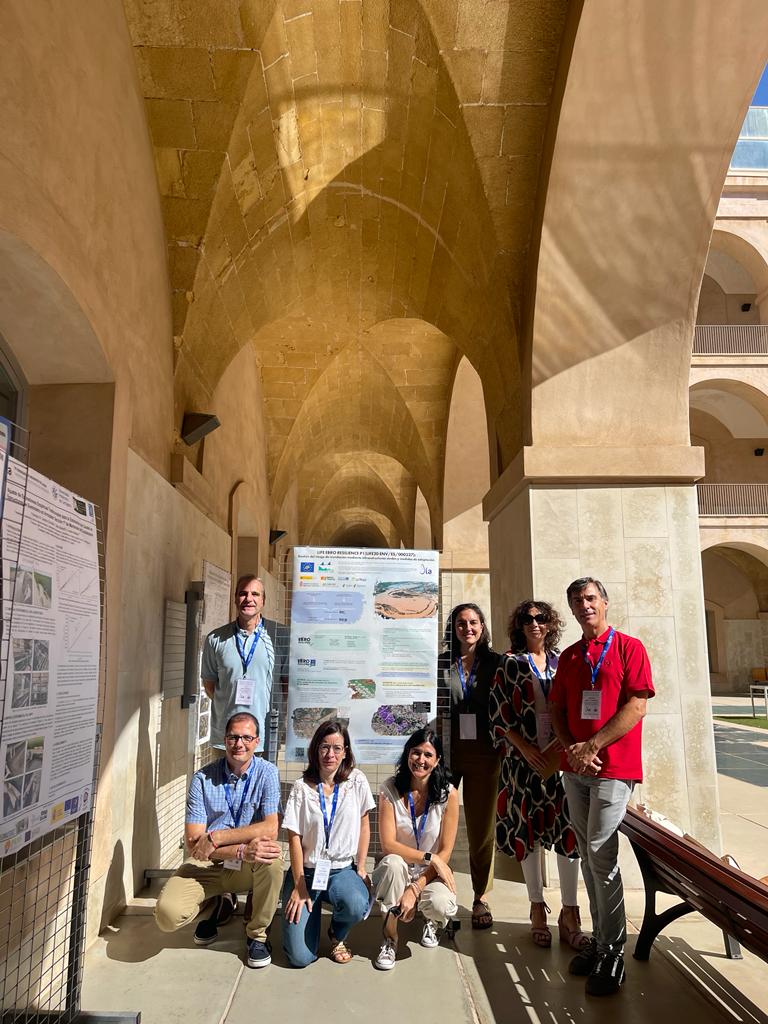The technical team of LIFE Ebro Resilience P1 has participated in the VII Water Engineering Conference organized by the University of Cartagena on October 18 and 19 in this Murcian town.
They have done it with a poster and an article article dedicated to the actions of the LIFE Project and its objectives, which have been presented by technicians from all the partners: Ministry for Ecological Transition and Demographic Challenge (MITECO), through its companies TRAGSA and TRAGSATEC; Ebro Hydrographic Confederation; Government of La Rioja; Government of Navarra, through Gestión Ambiental de Navarra, S.A. (GAN-NIK); Government of Aragón and the Aragonese Water Institute.
In addition, around the document presented, they explained the details of the project to those attending the conference.
The central theme of the documents is flood risk management through green infrastructure and adaptation measures. The project has three main objectives:
- Demonstrate that river restoration of meandering streams reduces the risk of flooding in the properties bordering the channel
- Proving that adaptation of an intensive agricultural area reduces damage from unavoidable floods
- Strengthen the social capacities of the local population for flood risk management and involve them in the implementation of the project.
LIFE Ebro Resilience P1 aims to be a tool to promote the implementation of the European Flood Directive, and therefore is an important part of the Ebro Flood Risk Management Plan that includes all the measures to reduce the risks generated by floods to human health, the environment, cultural heritage and economic activity.


The green infrastructure being created in zone 1, the Alfaro (La Rioja) – Castejón (Navarra) section , is demonstrative of the positive effect of the implementation of the Water Framework and Flood Directives.
This section is in addition to other actions already carried out or in the definition phase through the Ebro Resilience Strategy. This is the so-called combined section of actions with actions that, taken together, involve successive natural water retention measures that achieve a measurable improvement in terms of flood damage reduction at the section level.


In zone 2 (Osera de Ebro – Fuentes de Ebro, in Zaragoza), adaptation actions are planned. Lateral flow buffer zones (LFZs) will be created, which consist of compartmentalizing and pre-flooding agricultural areas to create water buffers that minimize damage to land and infrastructure. The innovation of the proposal lies in the operation of these flooded areas.
While in the known actions the water is temporarily and statically stored during the passage of the flood, the AFZs will be conditioned to allow the passage of the overflowing water continuously over the flooded areas. Thus, the water will flow parallel to the riverbed and contribute to flood drainage.
Green Infrastructure Strategy
The LIFE Project implements the “EU Strategy on Green Infrastructure” dedicated to restoring ecosystem health and allowing species to thrive in their natural habitat, which in Spain is implemented through the “National Strategy for Green Infrastructure and Ecological Connectivity and Restoration”. LIFE EBRO RESILIENCE P1 will contribute to the implementation of the Habitats Directive 92/43/EEC, on the conservation of natural habitats, wild fauna and flora, promoting the maintenance and improvement of biodiversity, as it will develop the programs of measures of the 3 Red Natura 2000 sites present in the intervention area (SAC ES2300006, SAC ES2200040 and SAC ES2430081).
The LIFE Ebro Resilience P1 Project (LIFE20 ENV/ES/00327), approved by the European Commission in the LIFE 2020 call, covers three autonomous communities (La Rioja, Navarra and Aragón), has a duration of 6 years and a total budget of 13,310,350 €, with 55% European funding.


